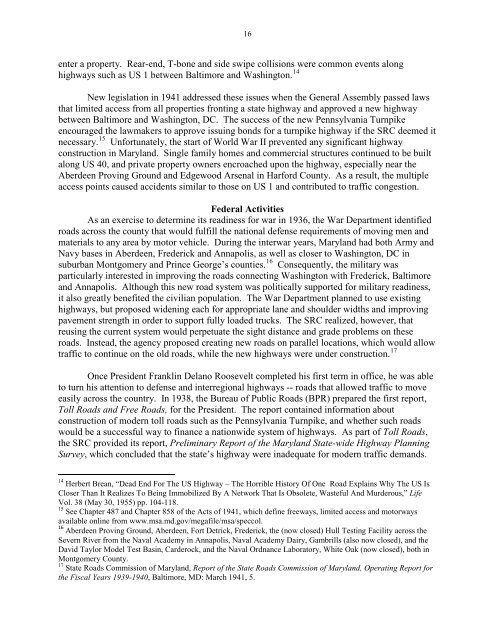TOMORROW'S ROADS TODAY - Maryland State Highway ...
TOMORROW'S ROADS TODAY - Maryland State Highway ...
TOMORROW'S ROADS TODAY - Maryland State Highway ...
Create successful ePaper yourself
Turn your PDF publications into a flip-book with our unique Google optimized e-Paper software.
16<br />
enter a property. Rear-end, T-bone and side swipe collisions were common events along<br />
highways such as US 1 between Baltimore and Washington. 14<br />
New legislation in 1941 addressed these issues when the General Assembly passed laws<br />
that limited access from all properties fronting a state highway and approved a new highway<br />
between Baltimore and Washington, DC. The success of the new Pennsylvania Turnpike<br />
encouraged the lawmakers to approve issuing bonds for a turnpike highway if the SRC deemed it<br />
necessary. 15 Unfortunately, the start of World War II prevented any significant highway<br />
construction in <strong>Maryland</strong>. Single family homes and commercial structures continued to be built<br />
along US 40, and private property owners encroached upon the highway, especially near the<br />
Aberdeen Proving Ground and Edgewood Arsenal in Harford County. As a result, the multiple<br />
access points caused accidents similar to those on US 1 and contributed to traffic congestion.<br />
Federal Activities<br />
As an exercise to determine its readiness for war in 1936, the War Department identified<br />
roads across the county that would fulfill the national defense requirements of moving men and<br />
materials to any area by motor vehicle. During the interwar years, <strong>Maryland</strong> had both Army and<br />
Navy bases in Aberdeen, Frederick and Annapolis, as well as closer to Washington, DC in<br />
suburban Montgomery and Prince George’s counties. 16 Consequently, the military was<br />
particularly interested in improving the roads connecting Washington with Frederick, Baltimore<br />
and Annapolis. Although this new road system was politically supported for military readiness,<br />
it also greatly benefited the civilian population. The War Department planned to use existing<br />
highways, but proposed widening each for appropriate lane and shoulder widths and improving<br />
pavement strength in order to support fully loaded trucks. The SRC realized, however, that<br />
reusing the current system would perpetuate the sight distance and grade problems on these<br />
roads. Instead, the agency proposed creating new roads on parallel locations, which would allow<br />
traffic to continue on the old roads, while the new highways were under construction. 17<br />
Once President Franklin Delano Roosevelt completed his first term in office, he was able<br />
to turn his attention to defense and interregional highways -- roads that allowed traffic to move<br />
easily across the country. In 1938, the Bureau of Public Roads (BPR) prepared the first report,<br />
Toll Roads and Free Roads, for the President. The report contained information about<br />
construction of modern toll roads such as the Pennsylvania Turnpike, and whether such roads<br />
would be a successful way to finance a nationwide system of highways. As part of Toll Roads,<br />
the SRC provided its report, Preliminary Report of the <strong>Maryland</strong> <strong>State</strong>-wide <strong>Highway</strong> Planning<br />
Survey, which concluded that the state’s highway were inadequate for modern traffic demands.<br />
14 Herbert Brean, “Dead End For The US <strong>Highway</strong> – The Horrible History Of One Road Explains Why The US Is<br />
Closer Than It Realizes To Being Immobilized By A Network That Is Obsolete, Wasteful And Murderous,” Life<br />
Vol. 38 (May 30, 1955) pp. 104-118.<br />
15 See Chapter 487 and Chapter 858 of the Acts of 1941, which define freeways, limited access and motorways<br />
available online from www.msa.md.gov/megafile/msa/speccol.<br />
16 Aberdeen Proving Ground, Aberdeen, Fort Detrick, Frederick, the (now closed) Hull Testing Facility across the<br />
Severn River from the Naval Academy in Annapolis, Naval Academy Dairy, Gambrills (also now closed), and the<br />
David Taylor Model Test Basin, Carderock, and the Naval Ordnance Laboratory, White Oak (now closed), both in<br />
Montgomery County.<br />
17 <strong>State</strong> Roads Commission of <strong>Maryland</strong>, Report of the <strong>State</strong> Roads Commission of <strong>Maryland</strong>, Operating Report for<br />
the Fiscal Years 1939-1940, Baltimore, MD: March 1941, 5.
















